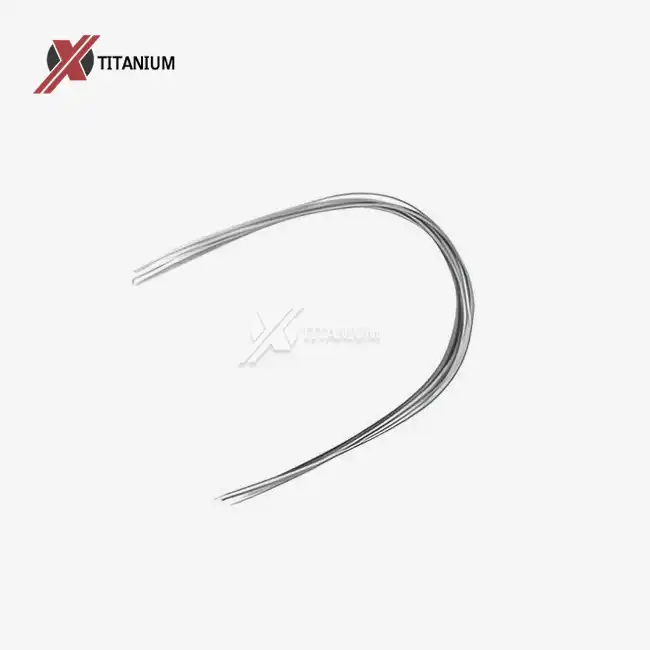The Composition and Properties of Nickel Titanium Memory Wire
Chemical Composition and Structure
Nickel titanium memory wire, often referred to as Nitinol, is an equiatomic intermetallic compound composed of approximately 50% nickel and 50% titanium. This precise balance of elements is crucial for the alloy's unique properties. The crystal structure of nickel titanium transitions between two phases: austenite (high-temperature phase) and martensite (low-temperature phase). This phase transformation is the key to its shape memory and superelastic behavior.
Unique Properties of Nickel Titanium
The exceptional properties of nickel titanium memory wire set it apart from conventional materials:
- Shape Memory Effect: The ability to "remember" and return to its original shape when heated above its transformation temperature.
- Superelasticity: The capacity to undergo large deformations and spring back to its original shape upon unloading.
- High Strength: Impressive tensile strength, often surpassing that of many steels.
- Corrosion Resistance: Excellent resistance to various corrosive environments, including bodily fluids.
- Biocompatibility: Safe for use in medical implants due to its non-toxic nature.
- Fatigue Resistance: Ability to withstand repeated cycling without significant degradation.
Manufacturing Processes
The production of nickel titanium memory wire involves several sophisticated processes:
- Melting and Casting: Precise mixing of nickel and titanium in a vacuum or inert atmosphere to prevent contamination.
- Hot Working: Shaping the ingot into a wire through processes like hot rolling or hot extrusion.
- Cold Working: Further reducing the wire diameter and improving mechanical properties.
- Heat Treatment: Crucial for setting the shape memory effect and fine-tuning properties.
- Surface Treatment: May include pickling, polishing, or coating to enhance surface properties.
These processes require precision and expertise to achieve the desired properties in the final product.
Applications and Advantages of Nickel Titanium Memory Wire
Medical Applications
The biocompatibility and unique properties of nickel titanium memory wire make it invaluable in the medical field:
- Stents: Self-expanding stents that adapt to vessel shapes and maintain patency.
- Orthodontic Archwires: Provide consistent force for teeth alignment.
- Surgical Instruments: Flexible endoscopes and minimally invasive tools.
- Implants: Bone plates, spinal vertebrae spacers, and artificial heart valves.
Aerospace and Automotive Industries
The aerospace and automotive sectors leverage the strength and adaptability of nickel titanium:
- Actuators: Compact, lightweight alternatives to hydraulic systems.
- Vibration Damping: Absorbing and dissipating mechanical energy in structures.
- Coupling Devices: Temperature-activated fasteners and connectors.
- Adaptive Wings: Morphing airfoils for improved aerodynamic performance.
Consumer Electronics and Robotics
The versatility of nickel titanium extends to everyday technology:
- Antenna: Deployable and retractable antennas in mobile devices.
- Eyeglass Frames: Durable and flexible frames that resist deformation.
- Robotic Actuators: Compact, powerful actuators for robotic limbs and grippers.
- Smart Fabrics: Integrating shape memory fibers for responsive clothing.
Challenges and Future Developments in Nickel Titanium Technology
Current Limitations and Challenges
Despite its remarkable properties, nickel titanium memory wire faces several challenges:
- Cost: Higher production costs compared to conventional materials.
- Processing Complexity: Requires specialized equipment and expertise.
- Narrow Temperature Range: Optimal performance limited to specific temperature ranges.
- Fatigue in Certain Applications: Potential for degradation under specific cyclic loading conditions.
- Nickel Sensitivity: Concerns about allergic reactions in some medical applications.
Ongoing Research and Innovation
Scientists and engineers are actively working to address these challenges and expand the potential of nickel titanium:
- Alloy Optimization: Developing new compositions to enhance properties and broaden temperature ranges.
- Advanced Manufacturing Techniques: Exploring 3D printing and powder metallurgy for complex shapes.
- Surface Modifications: Improving biocompatibility and reducing nickel leaching.
- Composite Materials: Integrating nickel titanium with other materials for enhanced performance.
- Nanotechnology: Investigating nanoscale effects on shape memory and superelastic properties.
Emerging Applications
The unique properties of nickel titanium are opening doors to novel applications:
- Energy Harvesting: Converting thermal energy into mechanical work.
- Self-Healing Materials: Utilizing shape memory for automatic damage repair.
- Soft Robotics: Creating flexible, adaptable robotic structures.
- Space Exploration: Developing deployable structures and adaptive components for spacecraft.
- Smart Infrastructure: Incorporating shape memory alloys in earthquake-resistant buildings.
Conclusion
Nickel titanium memory wire stands as a testament to the power of materials science in revolutionizing various industries. Its unparalleled combination of strength, flexibility, and shape memory properties makes it an indispensable material in medical, aerospace, and consumer applications. While challenges such as cost and processing complexity persist, ongoing research and innovation continue to expand its potential. As we look to the future, nickel titanium memory wire is poised to play an increasingly crucial role in developing smart, adaptive technologies that push the boundaries of what's possible in engineering and design.
Are you intrigued by the possibilities of nickel titanium memory wire? At Baoji Chuanglian New Metal Material Co., Ltd., we specialize in manufacturing high-quality titanium products, including China nickel titanium memory wire. Our expertise in titanium and rare metal products ensures that you receive materials that meet the highest standards of performance and reliability. Whether you're in the medical, aerospace, or industrial sector, we have the solutions to meet your specific needs. Contact us today at info@cltifastener.com or djy6580@aliyun.com to discuss how our nickel titanium memory wire can elevate your next project.
FAQs
What surface finishes are available for nickel titanium memory wire?
We offer various surface finishes including bright, polished, pickled, acid cleaned, and sandblasted surfaces to suit different application requirements.
What quality tests are performed on nickel titanium memory wire?
Our quality assurance includes hardness tests, bending tests, and hydrostatic tests among others to ensure optimal performance.
What are the key features of nickel titanium memory wire?
Nickel titanium memory wire boasts high corrosion resistance, low density, and good thermal stability, making it ideal for various applications.
In which industries is nickel titanium memory wire commonly used?
It finds applications in chemical industries, various industrial sectors, sports equipment manufacturing, and many other fields requiring its unique properties.
References
1. Duerig, T., Pelton, A., & Stöckel, D. (1999). An overview of nitinol medical applications. Materials Science and Engineering: A, 273, 149-160.
2. Mohd Jani, J., Leary, M., Subic, A., & Gibson, M. A. (2014). A review of shape memory alloy research, applications and opportunities. Materials & Design, 56, 1078-1113.
3. Otsuka, K., & Ren, X. (2005). Physical metallurgy of Ti–Ni-based shape memory alloys. Progress in Materials Science, 50(5), 511-678.
4. Sun, L., Huang, W. M., Ding, Z., Zhao, Y., Wang, C. C., Purnawali, H., & Tang, C. (2012). Stimulus-responsive shape memory materials: A review. Materials & Design, 33, 577-640.
5. Yamauchi, K., Ohkata, I., Tsuchiya, K., & Miyazaki, S. (Eds.). (2011). Shape memory and superelastic alloys: Technologies and applications. Woodhead Publishing.




_1747364744942.webp)